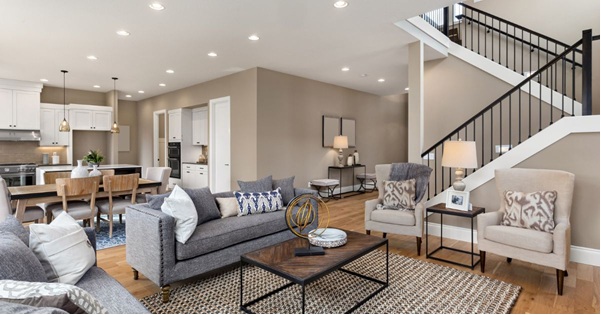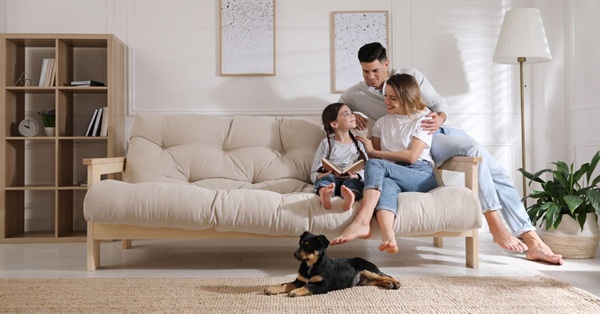
Sectionals vs. Sofas: Which Is Right for Your Space?
Your living room is the gathering place where your family reconnects after long days and your friends create lasting memories. Choosing between a sectional and a traditional sofa can feel difficult when you’re trying to create the perfect space for your lifestyle.
The decision goes beyond simple aesthetics. You need to consider your room’s layout, how you use the space, and what fits your budget. Whether you’re furnishing your first apartment or upgrading your family room, knowing which is right for your space is nonnegotiable for a comfortable, practical interior flow. Let’s break down sectionals and sofas to give you a look at the differences.
What Defines a Sectional vs. a Traditional Sofa?
A traditional sofa features a single, unified piece of furniture designed to seat three to four people in a straight line. Sectionals consist of multiple connected pieces that form an L-shape, U-shape, or curved configuration, typically offering seating for five or more people.
Sectionals come in various configurations, from simple two-piece corner units to elaborate arrangements with chaises, ottomans, and recliners. Traditional sofas maintain their classic rectangular shape but vary in size from compact loveseats to oversized models. Knowing these key distinctions will serve as a great starting point for your shopping experience.
How Much Space Do You Actually Need?
Room size plays the most critical role in your decision. Sectionals require substantial floor space—typically a minimum of 10x12 feet for smaller L-shaped models. Larger U-shaped sectionals need rooms measuring at least 12x15 feet to avoid overwhelming the space.
Traditional sofas work better in compact areas. A standard three-seat sofa measures about 84 inches long and 36 inches deep, making it suitable for rooms as small as 8x10 feet. This flexibility allows you to incorporate additional seating like accent chairs or ottomans.
Which Option Seats More People Comfortably?
Sectionals win the capacity contest hands down. Most L-shaped sectionals accommodate five to six adults comfortably, while larger configurations can seat eight or more people. The corner section provides additional seating that doesn’t exist in traditional sofas.
Traditional sofas typically seat three adults comfortably, though larger models can accommodate four. You’ll need multiple pieces—perhaps a sofa plus loveseat or additional chairs—to match a sectional’s seating capacity.
Family size and entertaining habits should also guide your choice. Large families or frequent hosts often find sectionals more practical, while smaller households may prefer the intimate feel of a traditional sofa arrangement.

What’s the Cost Difference Between the Two?
Sectionals generally cost more upfront due to their size and complexity. Entry-level sectionals start around $800 and go up to $1,200, while quality options range from $1,500 to $4,000. Premium sectionals with features like reclining sections or high-end materials can exceed $6,000.
Traditional sofas offer more price flexibility. Basic models start around $400 to $600, mid-range options cost $800 – $2,000, and luxury sofas can reach $4,000 or more. The single-piece construction often makes sofas more affordable than sectionals with comparable quality.
Grand Furniture offers financing options that make living room furniture on credit accessible for sectionals and sofas, allowing you to spread payments over time while enjoying your new furniture immediately.
How Do Layout Options Compare?
Sectionals create natural conversation areas by forming intimate seating arrangements. The L-shape encourages face-to-face interaction and works particularly well for families who spend significant time together in the living room.
Traditional sofas offer superior flexibility for room arrangements. You can position them against walls, float them in the room’s center, or angle them toward focal points like fireplaces or entertainment centers. This versatility makes sofas easier to incorporate into existing decor schemes.
Room shape affects your options significantly. Sectionals work best in square or rectangular rooms with clear corners, while sofas adapt to irregular room shapes and challenging layouts more easily.
What Are the Comfort and Functionality Differences?
Sectionals often feature built-in functionality that traditional sofas lack. Many models include the following features:
- Reclining sections for enhanced relaxation
- Storage compartments in ottoman sections
- Cup holders and USB charging ports
- Chaise lounges for stretching out
- Convertible sections that transform into beds
Which Style Works Better for Different Room Shapes?
L-shaped rooms naturally accommodate sectionals, as the furniture’s configuration mirrors the space’s layout. Open floor plans also work well with sectionals, which can define separate areas within larger spaces.
Long, narrow rooms favor traditional sofas placed along the length of the space. Sofas also work better in rooms with multiple doorways or windows that limit corner placement options.
Square rooms offer the most flexibility for either choice, though sectionals can make smaller square rooms feel cramped while larger square spaces benefit from sectionals’ substantial presence.

How Easy Are They To Move and Rearrange?
Traditional sofas win for mobility and flexibility. Their single-piece construction makes them easier to move when cleaning or rearranging, though they’re still heavy and awkward to transport between rooms or homes.
Sectionals present moving challenges due to their size and modular nature. However, their separate pieces can make transportation easier during major moves. Some modular sectionals allow you to reconfigure pieces for different arrangements.
Consider your long-term plans when choosing a couch for your space. Renters or frequent movers might prefer traditional sofas’ flexibility, while homeowners planning to stay put can embrace sectionals’ permanence.
What Maintenance Requirements Should You Expect?
Sectionals require more maintenance attention due to their multiple seams and crevices where debris accumulates. The connection points between sections need regular inspection to support stability and prevent wear.
Traditional sofas offer simpler maintenance with uniform surfaces and fewer joints to monitor. Their single-piece construction typically means more even wear patterns and easier professional cleaning.
Which Option Offers Better Long-Term Value?
Sectionals often provide better value per seat when you calculate cost per person accommodated. Their durability and substantial construction can justify higher upfront costs over time.
Traditional sofas offer flexibility value that’s harder to quantify. Their ability to work in different spaces and arrangements can extend their useful life as your needs change.
Make Your Final Decision With Grand Furniture
Making the right choice between a sectional and traditional sofa depends on balancing space, lifestyle, and budget considerations. Sectionals excel in large spaces where you need maximum seating and don’t mind sacrificing flexibility. Traditional sofas work better for smaller spaces, frequent movers, or those who enjoy changing their room’s layout regularly.
Measure your space carefully and consider how you actually use your living room. When you’re ready, Grand Furniture is available to make this decision possible.


